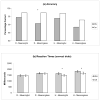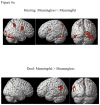Dissociating neural correlates of meaningful emblems from meaningless gestures in deaf signers and hearing non-signers
- PMID: 22968047
- PMCID: PMC3477813
- DOI: 10.1016/j.brainres.2012.08.029
Dissociating neural correlates of meaningful emblems from meaningless gestures in deaf signers and hearing non-signers
Abstract
Emblems are meaningful, culturally-specific hand gestures that are analogous to words. In this fMRI study, we contrasted the processing of emblematic gestures with meaningless gestures by pre-lingually Deaf and hearing participants. Deaf participants, who used American Sign Language, activated bilateral auditory processing and associative areas in the temporal cortex to a greater extent than the hearing participants while processing both types of gestures relative to rest. The hearing non-signers activated a diverse set of regions, including those implicated in the mirror neuron system, such as premotor cortex (BA 6) and inferior parietal lobule (BA 40) for the same contrast. Further, when contrasting the processing of meaningful to meaningless gestures (both relative to rest), the Deaf participants, but not the hearing, showed greater response in the left angular and supramarginal gyri, regions that play important roles in linguistic processing. These results suggest that whereas the signers interpreted emblems to be comparable to words, the non-signers treated emblems as similar to pictorial descriptions of the world and engaged the mirror neuron system.
Copyright © 2012 Elsevier B.V. All rights reserved.
Figures








Similar articles
-
CNS activation and regional connectivity during pantomime observation: no engagement of the mirror neuron system for deaf signers.Neuroimage. 2010 Jan 1;49(1):994-1005. doi: 10.1016/j.neuroimage.2009.08.001. Epub 2009 Aug 11. Neuroimage. 2010. PMID: 19679192 Free PMC article.
-
Neural responses to meaningless pseudosigns: evidence for sign-based phonetic processing in superior temporal cortex.Brain Lang. 2011 Apr;117(1):34-8. doi: 10.1016/j.bandl.2010.10.003. Epub 2010 Nov 20. Brain Lang. 2011. PMID: 21094525 Free PMC article.
-
Distinguishing the processing of gestures from signs in deaf individuals: an fMRI study.Brain Res. 2009 Jun 18;1276:140-50. doi: 10.1016/j.brainres.2009.04.034. Epub 2009 May 3. Brain Res. 2009. PMID: 19397900 Free PMC article.
-
The bimodal bilingual brain: effects of sign language experience.Brain Lang. 2009 May-Jun;109(2-3):124-32. doi: 10.1016/j.bandl.2008.03.005. Epub 2008 May 8. Brain Lang. 2009. PMID: 18471869 Free PMC article. Review.
-
Signed language working memory capacity of signed language interpreters and deaf signers.J Deaf Stud Deaf Educ. 2013 Apr;18(2):271-86. doi: 10.1093/deafed/ens068. Epub 2013 Jan 9. J Deaf Stud Deaf Educ. 2013. PMID: 23303377 Review.
Cited by
-
Neural basis of understanding communicative actions: Changes associated with knowing the actor's intention and the meanings of the actions.Neuropsychologia. 2016 Jan 29;81:230-237. doi: 10.1016/j.neuropsychologia.2016.01.002. Epub 2016 Jan 2. Neuropsychologia. 2016. PMID: 26752450 Free PMC article.
-
Enhancement of visual biological motion recognition in early-deaf adults: Functional and behavioral correlates.PLoS One. 2020 Aug 10;15(8):e0236800. doi: 10.1371/journal.pone.0236800. eCollection 2020. PLoS One. 2020. PMID: 32776962 Free PMC article.
-
Rapid Eye Movement Sleep Behavior Disorder Manifesting as Sign Language in a Patient with Dementia with Lewy Bodies.Mov Disord Clin Pract. 2017 Apr 3;4(4):623-624. doi: 10.1002/mdc3.12486. eCollection 2017 Jul-Aug. Mov Disord Clin Pract. 2017. PMID: 30713970 Free PMC article. No abstract available.
-
Neural Networks Supporting Phoneme Monitoring Are Modulated by Phonology but Not Lexicality or Iconicity: Evidence From British and Swedish Sign Language.Front Hum Neurosci. 2019 Oct 22;13:374. doi: 10.3389/fnhum.2019.00374. eCollection 2019. Front Hum Neurosci. 2019. PMID: 31695602 Free PMC article.
-
Neural systems supporting linguistic structure, linguistic experience, and symbolic communication in sign language and gesture.Proc Natl Acad Sci U S A. 2015 Sep 15;112(37):11684-9. doi: 10.1073/pnas.1510527112. Epub 2015 Aug 17. Proc Natl Acad Sci U S A. 2015. PMID: 26283352 Free PMC article.
References
-
- Arbib MA. From monkey-like action recognition to human language: an evolutionary framework for neurolinguistics. Behav Brain Sci. 2005;28:105–24. discussion 125–67. - PubMed
-
- Aronoff M, Meir I, Padden C, Sandler W. Morphological universals and the sign language type. Yearbook of Morphology 2004. In: Booij G, Marle J, editors. Yearbook of Morphology. Springer; Netherlands: 2005. pp. 19–39.
-
- Bentin S, McCarthy G, Wood CC. Event-related potentials, lexical decision and semantic priming. Electroencephalogr Clin Neurophysiol. 1985;60:343–55. - PubMed
-
- Callan AM, Callan DE, Masaki S. When meaningless symbols become letters: neural activity change in learning new phonograms. Neuroimage. 2005;28:553–62. - PubMed
Publication types
MeSH terms
Grants and funding
LinkOut - more resources
Full Text Sources

